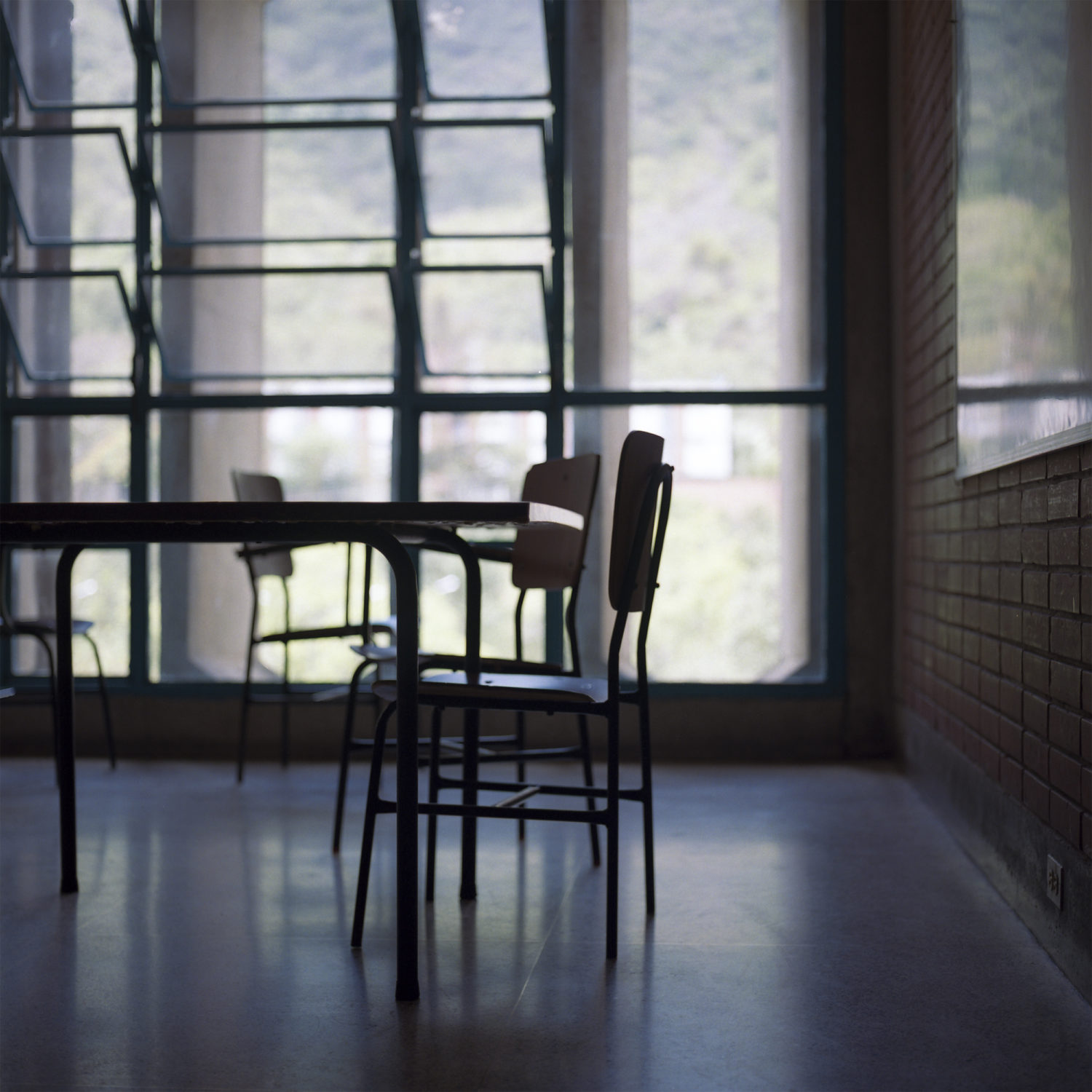
© Yorli Mendoza
We’re very proud to have been part of the brilliant Portfolio Review event at FORMAT Festival 2019. After a full day of reviews, all of the photographers were invited to put their work out on tables to be viewed by guests and reviewers alike. After the portfolio reviews, and portfolio walk, award winners were announced and prizes given to photographers.
This year our FORMAT Festival Shutter Hub Portfolio Award winner was the amazing Simona Ciocarlan, and after the event we also awarded a funded Shutter Hub membership to Carrie Ann Woolsey (via the Shutter Hub Membership Bursary Fund).
There’s always so much to see and take in at FORMAT, so we invited some of the standout photographers of the day to share their work with us here, so we can share them with you.
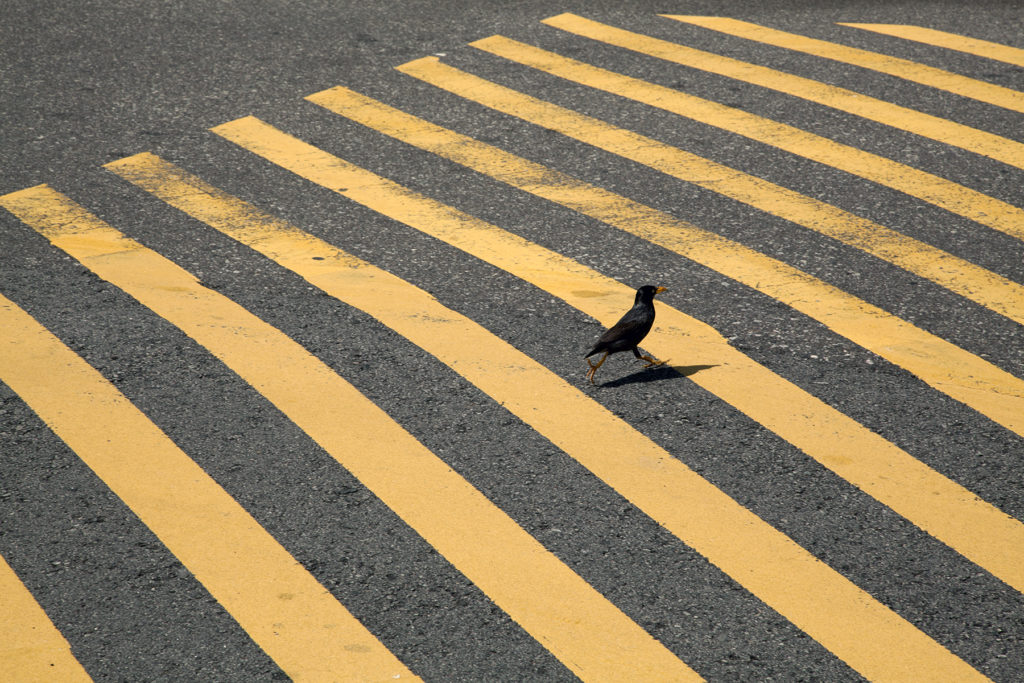
Mynah Walking with Me © Anaïs López
ANAIS LOPEZ – THE MIGRANT
It was in 2012 in Singapore that Anaïs López first came across the Javan mynah, a small black bird with a yellow beak and legs, a prominent crest, and a loud, raucous call. The Migrant tells the turbulent life story of the Javan mynah.
A member of the starling family, the bird is originally from Java (Indonesia) and was introduced in Singapore via the songbird trade in the early 20th century. Following the Second World War, Singapore underwent rapid change, quickly transforming from a rubber trading post into a modern metropolis. In an effort to compete with the increasing urban noise, the mynah’s beautiful singing voice became a shrill screech. This did not fit the image of Singapore being a perfect city. The Straits Times, Singapore’s national newspaper, even described the mynah as “the new terrorist”.
The Migrant addresses broader themes such as the complex relationship between humans and animals, the consequences of rapid urbanisation, and the position of ‘the other’, the unwanted outsider, in modern society. The Migrant tells a grim story of persecution and extermination, but there is also a ray of hope: mynah may be unwanted in Singapore, but in Myanmar people believe in the divine power of mynahs to fulfil wishes by acting as messengers to the gods. Perhaps the time has come for a new exodus.
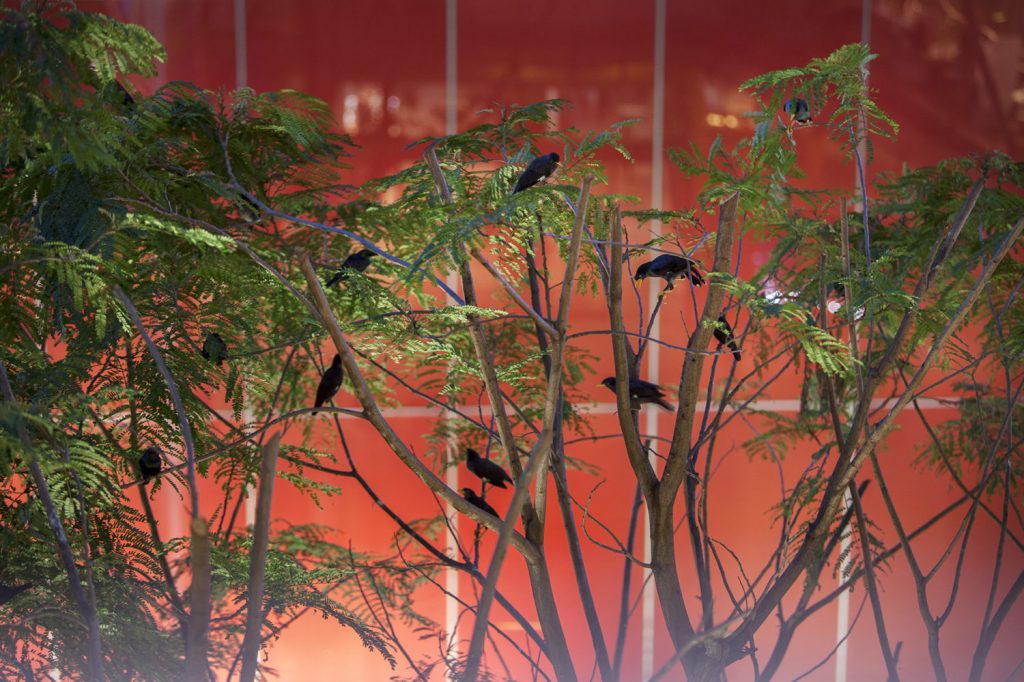
Orchard Road © Anaïs López
Anaïs López is a visual artist based in Amsterdam, who works with still and moving images. Besides working for magazines as an independent photographer, she makes documentaries about things that matter to her. In her work she investigates how people live in the city. What fascinates her is how people try to find (or make) a place in an urban area. The main theme in her work concerns the makeability of the city. In The Migrant she has gone one step further and investigated society as a whole. The Migrant is not just about how people relate to the city, but about how we deal with ‘the other’. The government of Singapore is trying to create an ideal city, but how desirable is that plan and who gets left out?
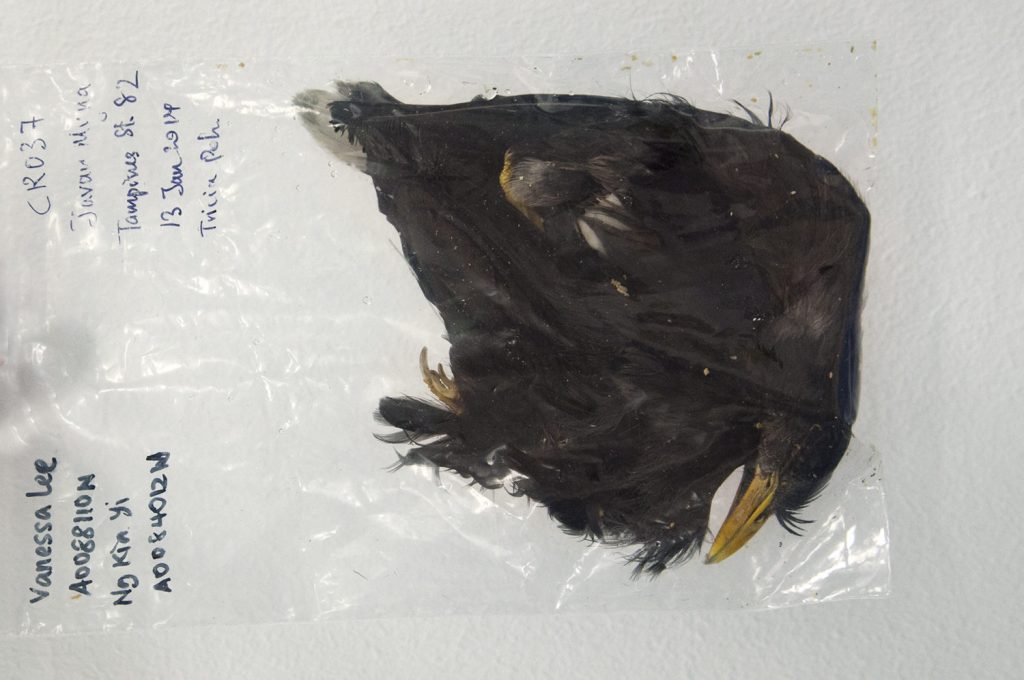
Dead Mynah © Anaïs López
Anaïs López is a storyteller above all else. Her work reflects this. In her current practice, photography has become more and more a means to an end and not an end unto itself. She switches between micro and macro levels and tries to combine the image of the city with a personal story, thus building a bridge between the private and the public spheres. She often undertakes collaborations with experts from other disciplines, artists and others, if the story demands it. Her final presentation reflects these collaborations. She consciously chooses to step outside of the usual presentation forms and platforms to reach new and different audiences. The Migrant for example is a book, an interactive web documentary, a radio documentary and a live performance, where Anaïs López tells the story live to small audiences with a monumental book that contains photographs, golden silk screens, comics and two pop-up images of Mynah, the protagonist of the story of The Migrant.
You can find out more about Anaïs López’ work here.
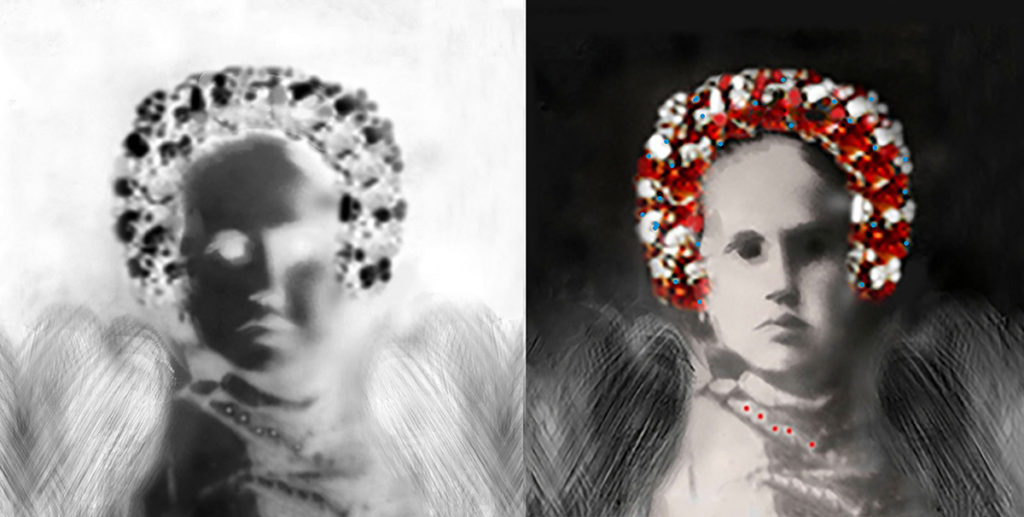
Transfiguration © Lesia Maruschak
LESIA MARUSCHAK – THE MARIA PROJECT
The MARIA Project memorialises the 1932-33 famine in Soviet Ukraine – the Holodomor – an event widely thought to be genocidal. The word Holodomor is a combination of the Ukrainian words for hunger (holod) and extermination (mor). It is a complex, highly debated, historical event. There are many vested interests, and hence many diverging stories. Eyewitness accounts attest to the fact that the famine was political and intentional; a state-sponsored assault on a single ethnic group as part of the Soviet Union’s new socio-economic model that required the subjugation of a sizeable population whose national consciousness stood in the way of the new order.
There are very few people still living who personally experienced the Holodomor. The artist knew three – all of whom are now dead from old age. Only one spoke of the event, describing the lack of food and how they ate the soles of their shoes. At the center of this project is a single vernacular image of a young girl, Maria F., who survived the Holodomor and currently resides in Canada. The MARIA Project began with screen captures gathered on the Internet. Maruschak eventually put out a call on Facebook and received one unexpected response: a family photograph of young Maria F. with her parents, taken in Ukraine. Maria F. became the heroine of the story.
Egg tempera, gold and various pigments are applied to images printed on kozo paper and then pigmented with ash, wax, resin and salt. These materials arise from the artist’s interest in Byzantine art. They oxidize when exposed to light and temperature changes, they bear traces of suppressed hand marks and finally they are degraded with audience’s human touch.
Maruschak wants this project to transform the ways we remember this tragedy, and inform how we relate to similar ones, keeping the experience of the art located in the present. The MARIA Project, conceived of as a memorial act, bears witness to the many phases of its own gestation, which eventually turns into a memory of its own creation, to be experienced in a public space. This process of memory-making is shared with audiences to capture multiple dimensions of time. The MARIA Project is a space for viewers to bear witness to an historical event by immersing themselves in a sensory experience and participating in the creation of individual and collective memories: themselves becoming creators of history.
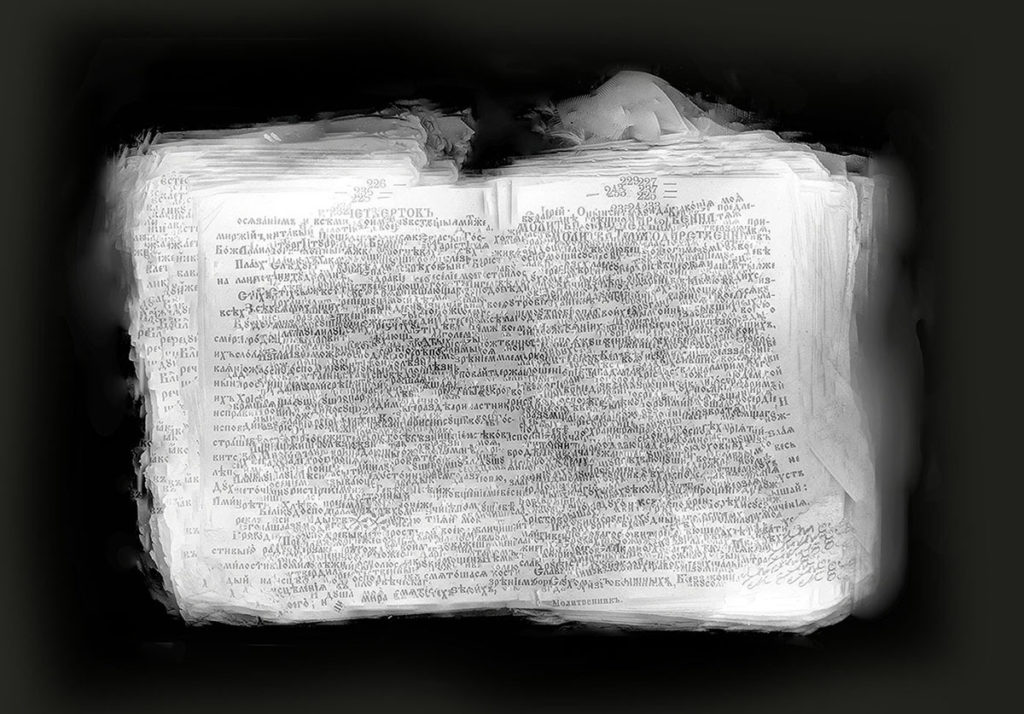
Four Million Prayers © Lesia Maruschak
Lesia Maruschak is a photography-based artist with a unique lens on the creation of mobile memorial spaces. Born in 1961 in Saskatchewan she spent her childhood on the Canadian prairies. Maruschak’s work informs and expands what it means to create memorials in an age where the “what and why of museums” is in question.
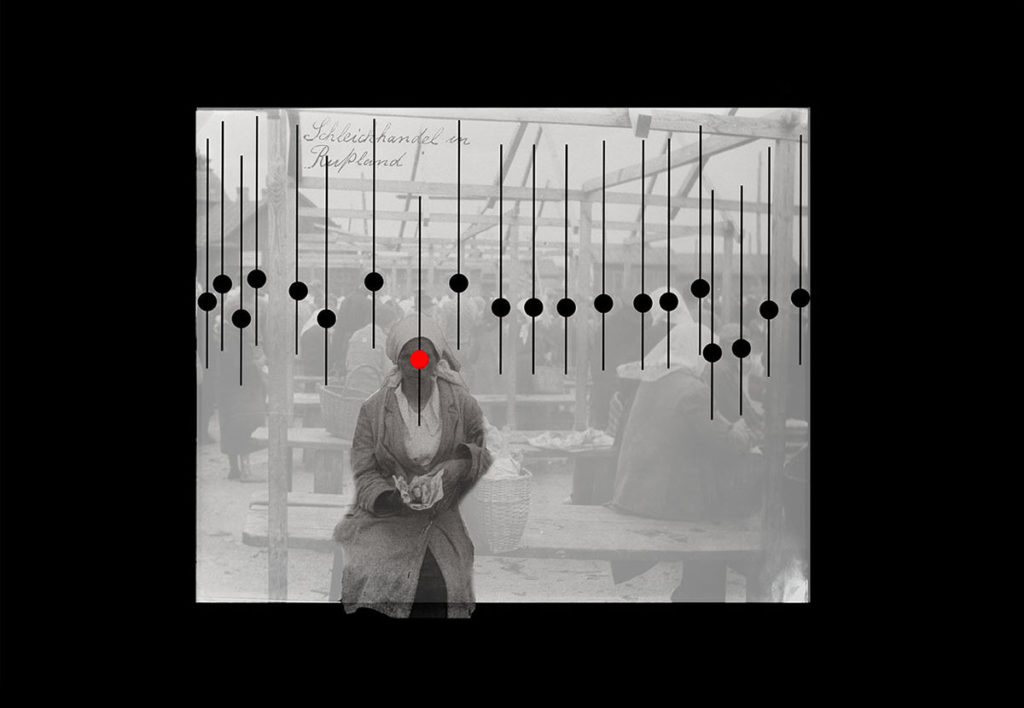
Four Fish to Sell © Lesia Maruschak
Her humanist approach and abstract sensual representation of modern-day atrocities set her apart from other photographers, at a time when photojournalism and documentary evidence continue to shape truth telling and proof seeking roles of memorial museums.
You can find out more about Lesia Maruschak’s work here.
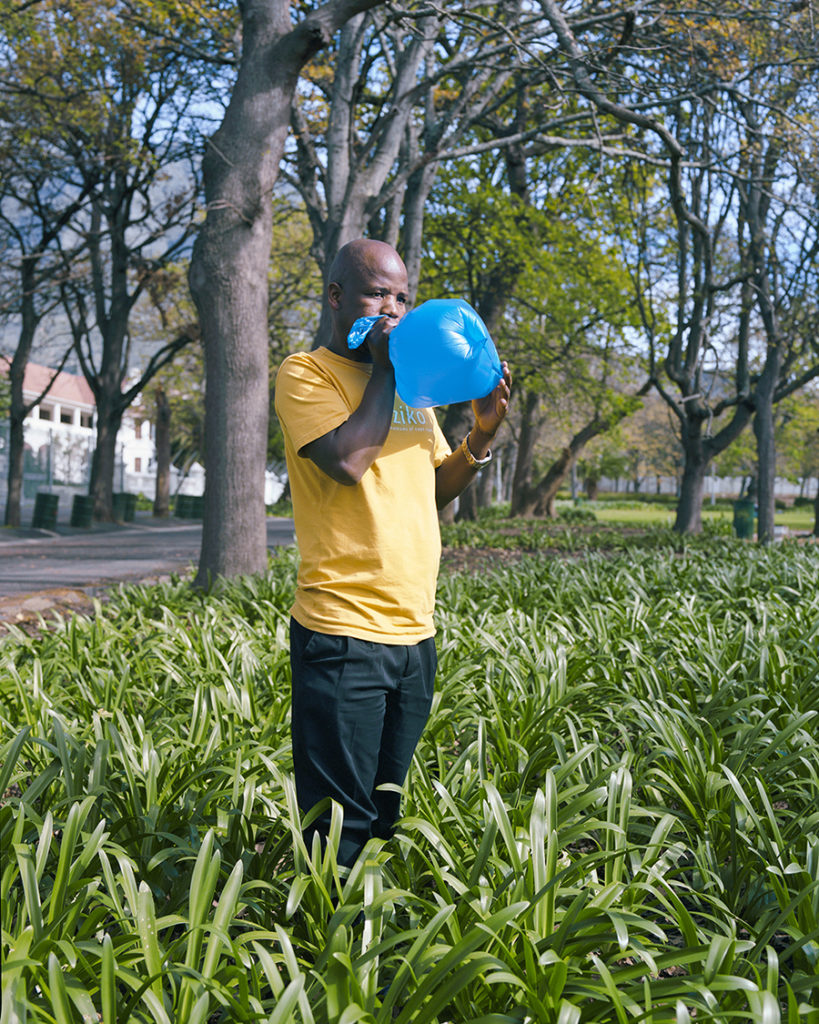
Blue Bag, Cape Town 2010 © Marysa Dowling
MARYSA DOWLING – BLUE BAG
Blue Bag is a 10-year project involving around 400 portrait sitters. What began as a commission by The Photographers Gallery in London to work with 30 people across the city became a long-term personal project spanning 11 cities across the world.
Utilizing the once-ubiquitous blue plastic bags from UK corner shops, Marysa Dowling created a series of unusual, collaborative portraits based on the simple premise of passing this ordinary, banal object from one person to the next with the intention of connecting communities and people while capturing the unique responses of each individual. Following the portraits in London, the series expanded to Havana, Los Angeles, Cape Town, Beirut, Ekenas, (Finland), Kochi (India), and Oaxaca, Guadalajara, Monterrey & Sayulita (Mexico).
Blue Bag began with a simple set of instructions for each participant:
1. Decide on a place where you would like to be photographed.
2. Think about what you will do with a blue plastic bag for the photograph.
3. With assistance, you will need to ensure that your body, the object and your chosen environment are included within the frame of the photograph.
4. After you have been photographed, the bag must be passed on to someone who is at least 10 years older or younger than you, they must not be directly related to you and should not know the person who has passed the object to you.
As the project travelled to these diverse cities the artist adapted the instructions as necessary, but the core methodology needed to remain consistent: choice of location, consideration of the bag within the portrait and choice of the next participant. As the project evolved, different ways of passing the bag developed, each particular to the city and the social codes of each location. In the hands of each participant the animation of the bag is a creative act, and meaning is made. The participant finds personal ways in which to re-imagine the object; in doing this we can speculate about what the bag signifies for the participant.
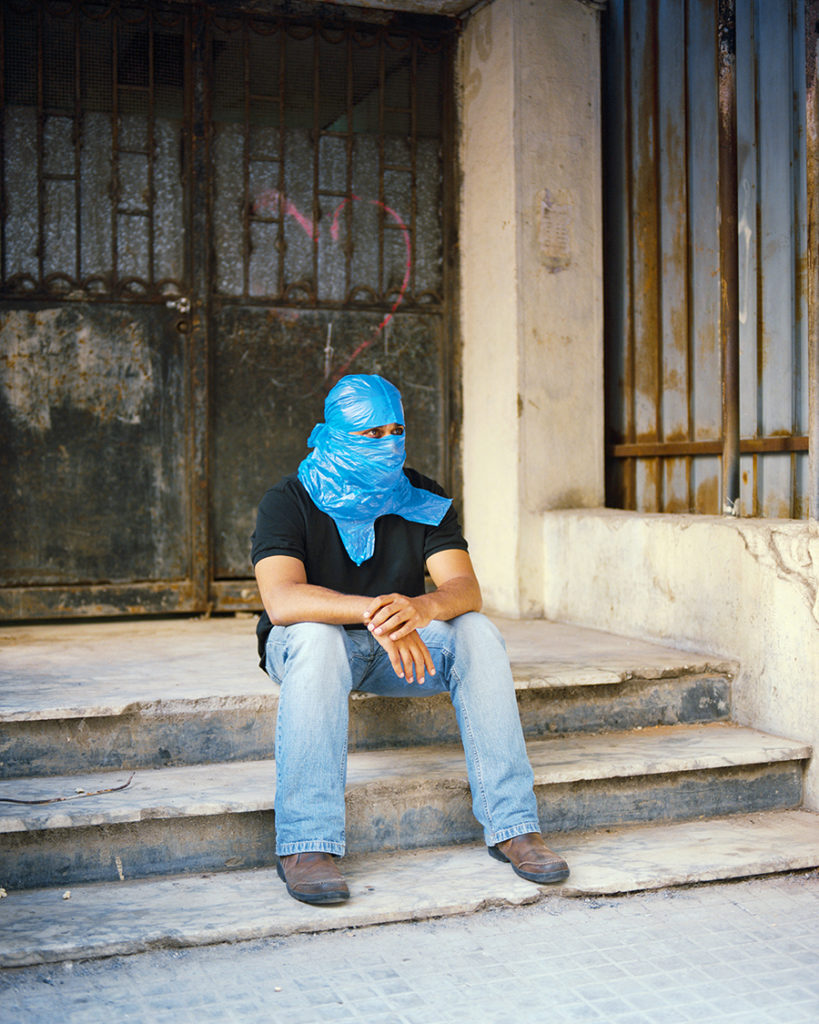
Blue Bag, Beirut 2010 © Marysa Dowling
Marysa Dowling’s practice is rooted within portraiture and concerned with human behaviour, identity, communication, exchange and interaction. Participation and collaborative possibilities are vital to her process.

Blue Bag, LA, 2008 #1 © Marysa Dowling
Predominantly her work is an exploration and observation of how people co-exist, relate to and interact with each other, and the various environments they inhabit. Photography is a way for Dowling to explore and understand the world. Her projects are often cross cultural in nature as she works in several countries cultivating the same theme. She builds connections across communities, societies and cultures. Her aim is to create thoughtful and playful photographic works that come into being through social interaction and exchange.
You can find out more about Marysa Dowling’s work here.
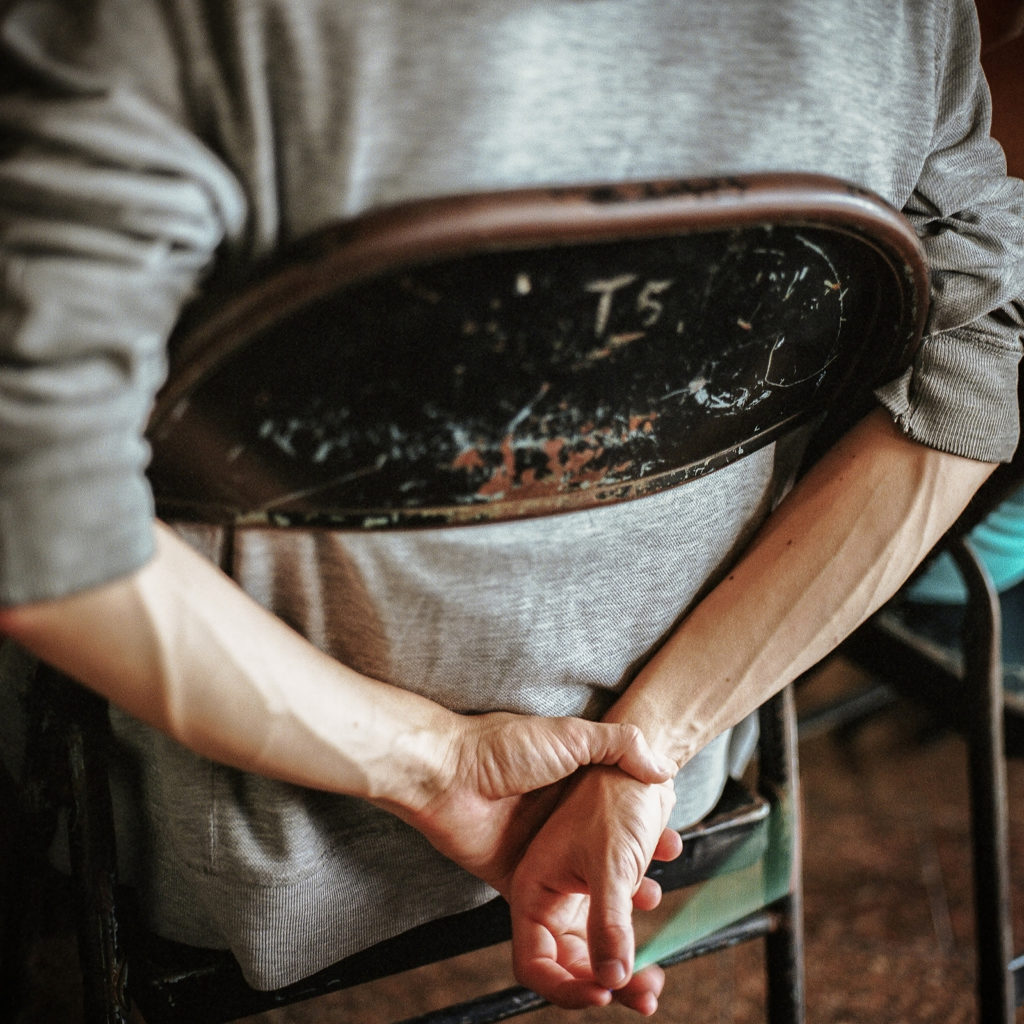
© Yorli Mendoza
YORLI MENDOZA – THROUGH THEIR EYES
This series attempts to reconstruct the loose narratives of the stories that young Venezuelans have told Yorli Mendoza to give an image of their country Through Their Eyes. These photos contrast the omnipresent portraits of Hugo Chavez and his successor Maduro that watch over Venezuelans like the Orwell’s Big Brother with the images of youngsters who have chosen to stay in the country in hope that this decaying society can one day be rebuilt.
The lie of adoration that the portraits of Chavez and Maduro disseminate attempts to conceal the uncertain political future of a deeply troubled nation, which is why the artist decided to depict what Venezuela really is today.
Capturing the images on a Hasselblad medium format analogue camera added fragility to the photographs and this approach seemed appropriate because going back to Venezuela felt like travelling back through time. Mendoza interviewed and photographed 12 young people between the age of 15 to 35 from different cities across Venezuela to have a broader picture of the situation and for them to talk about the country that was barely recognisable and to take the artist to places they though were important to document.
The portraits of brave young men and women who chose to face the adversity of the ongoing socioeconomic crisis are juxtaposed with cityscapes and landscapes that surround them with the aim of providing the spectator with a realistic view of their home country. To a certain degree, these images are like a web of thoughts and feelings that reveals the contradictions young Venezuelans are trying to reconcile. The relationships between people and places create a rich pallet of social observation. According to Mendoza, the air in Venezuela stinks of pessimism and frustration, but through these images that tell the stories of their protagonists, the artist hopes to offer a more optimistic perspective of the country’s future.
It is hard to imagine a sadder spectacle than seeing the hopes and dreams being stripped away from someone whose life is just beginning. But instead of being angry and feeling sorry for themselves, young Venezuelans do what they can with the resources they have. Their creativity, innovativeness, and imagination indicate that there is hope for Venezuela, but all this can be lost if their voices are not heard and it is too late to do anything to change their future.

© Yorli Mendoza
Yorli Mendoza is Venezuelan-born, London-based photographer and researcher. Mendoza currently work as freelance photographer in self-initiated projects that aim to directly challenge people’s ideas and expectations about particular subjects. The artist’s work focuses on social documentary and on people in the context of their own environment and seeks to find the most appropriate way of portraying the human condition and to explore the complex relationship between power structures and society. Mendoza is drawn to stories (from humanitarian to environmental) that challenge perceptions but are not often spotlighted in the news.
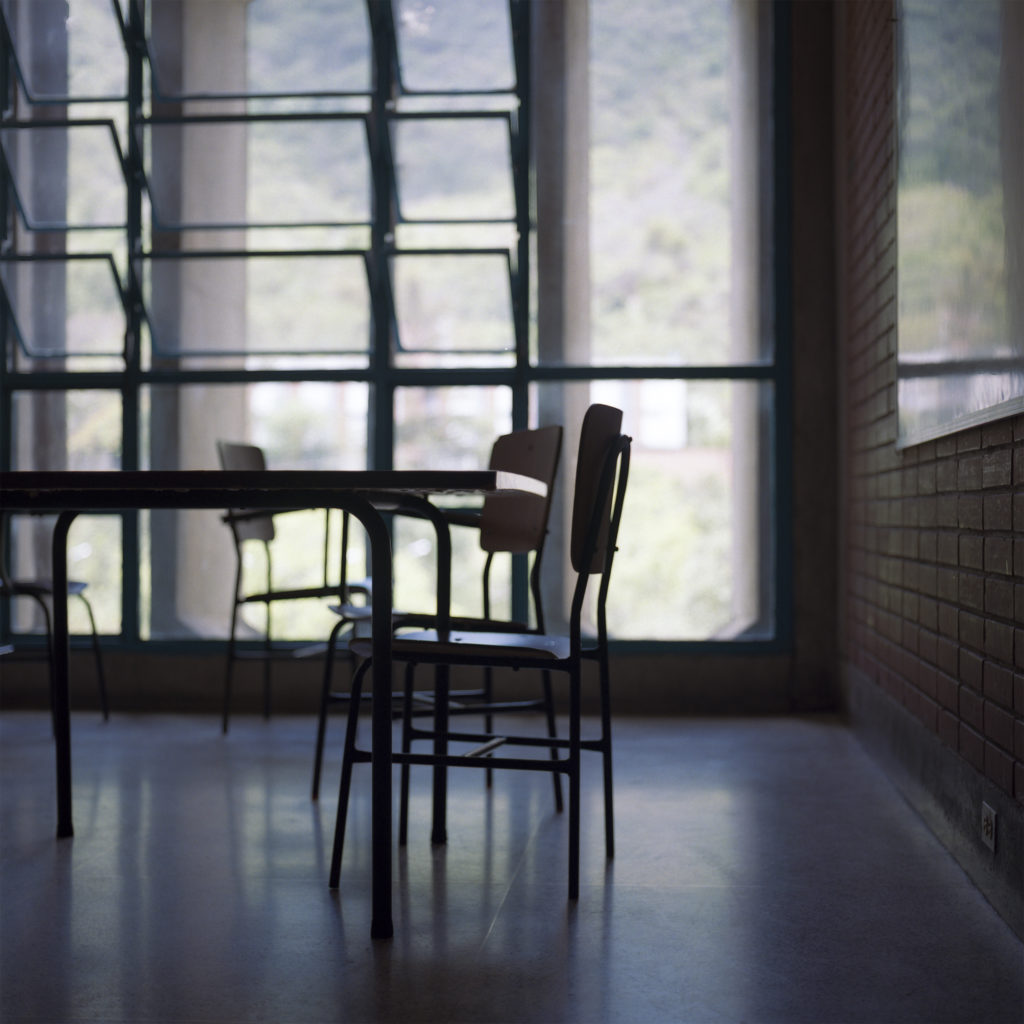
© Yorli Mendoza
Exploring all sorts of subjects there is one common element, the invisible. Those things that are intangible and elusive, that cannot be perceived easily to the eye, but can be felt and elicited through tangible, physical attributes using photography in combination with other methods. Mendoza’s projects range from straight documentary to conceptual and artist documenting. The photographer’s career as a social researcher is a strong influence. Creating a bridge between sociology and documentary photography, Mendoza uses the medium of photography as a personal
research tool to explore society and individuals.
You can find out more about Yorli Mendoza’s work here.
Not a Shutter Hub member yet? Join here for opportunities to promote your work online and in exhibitions, access selected opportunities, events, seminars and workshops, meet up and share photographic experiences, and become part of our growing community…























